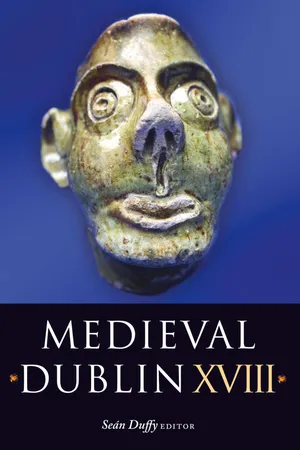
Medieval Dublin XVIII
Proceedings of the Friends of Medieval Dublin Symposium 2016
- 391 pages
- English
- PDF
- Available on iOS & Android
About this book
This volume contains a wealth of new research on Dublin's medieval past, including paired papers by Joseph Harbison and Rene Gapert that re-examine skulls found on the site of the Hospital of St John the Baptist, Thomas Street. Alan Hayden reports on his excavation of property plots fronting onto Kevin Street and New Street and what they tell us about the supposed fourteenth-century decline of Dublin, and Aisling Collins explains the significant findings from the dig of the church and graveyard at St James's. Antoine Giacometti examines a medieval tanning quarter that showcases leatherworking and shoemaking in medieval Dublin, complementing work by John Nicholl that analyses footwear styles in the late medieval city based on evidence excavated from Chancery Lane. This aspect of life is illustrated too in the findings of Paul Duffy's excavations in Thomas Street, which reveal a great deal about crafts in the western suburb of medieval Dublin. Franc Myles reports on the findings of his excavation at Keysar's Lane beside St Audeon's church in High Street, including some fascinatingly decorated medieval floor tiles; Jon Stirland reports on the discovery of two parallel ditches of possible early medieval/medieval date located to the rear of nos 19–22 Aungier Street; and Edmond O'Donovan describes his discoveries while excavating in the internal courtyard at the site of the Bank of Ireland at College Green, marked on Speed's 1610 map of Dublin as 'the hospital.' Historical papers include Denis Casey's analysis of Dublin's economy in its twelfth-century Irish context and Brian Coleman's study of taxation and resistance in fifteenth-century Dublin. Thomas W. Smith shines light on papal provisions to ecclesiastical benefices in thirteenth-century Dublin, while Stephen Hewer examines the oldest surviving original court roll of the Dublin bench, dating from 1290.
Frequently asked questions
- Essential is ideal for learners and professionals who enjoy exploring a wide range of subjects. Access the Essential Library with 800,000+ trusted titles and best-sellers across business, personal growth, and the humanities. Includes unlimited reading time and Standard Read Aloud voice.
- Complete: Perfect for advanced learners and researchers needing full, unrestricted access. Unlock 1.4M+ books across hundreds of subjects, including academic and specialized titles. The Complete Plan also includes advanced features like Premium Read Aloud and Research Assistant.
Please note we cannot support devices running on iOS 13 and Android 7 or earlier. Learn more about using the app.
Information
Table of contents
- Cover
- Dedication
- Title page
- Copyright page
- Table of contents
- List of abbreviations
- List of contributors
- Editor's preface
- Appreciation: Councillor John Gallagher
- The early medieval ecclesiastical enclosures of Dublin: exploring their character, chronology and evolving function in light of excavations across Ireland
- Dublin and the Gaelic Irish economy in the eleventh and twelfth centuries
- Saints’ dedications and the ecclesiastical landscape of Hiberno-Norse Dublin: Irish, Scandinavian and others
- Why were there so few papal provisions in thirteenth-century Dublin?
- ‘The Pale at prayer’: lived religious experience in Anglo-Norman Dublin’s two cathedrals
- Saints and skinners: excavations along the northern precinct of the abbey of St Thomas the Martyr, Dublin
- Blackpitts: Dublin’s medieval tanning quarter
- Dragons, giants and beautiful women: medieval Dublin in the European imagination
- St Sepulchre’s palace: new perspectives from recent excavations
- The parliamentary subsidy in fifteenth-century County Dublin and the men who collected it
- Late medieval footwear and leather finds from Chancery Lane, Dublin
- From mayor of Dublin to barons of Scrine: the Mareward family in Ireland, c.1360–1564